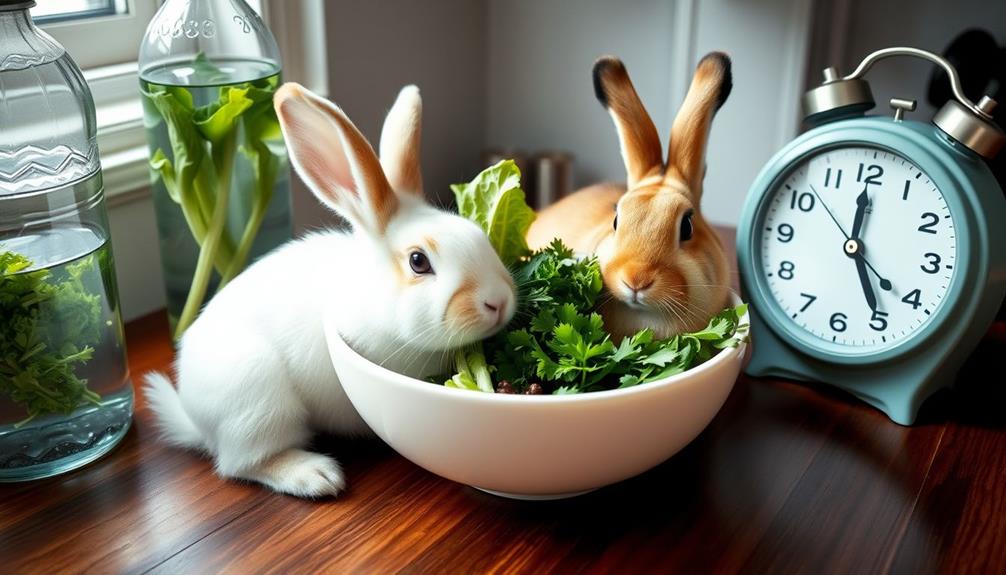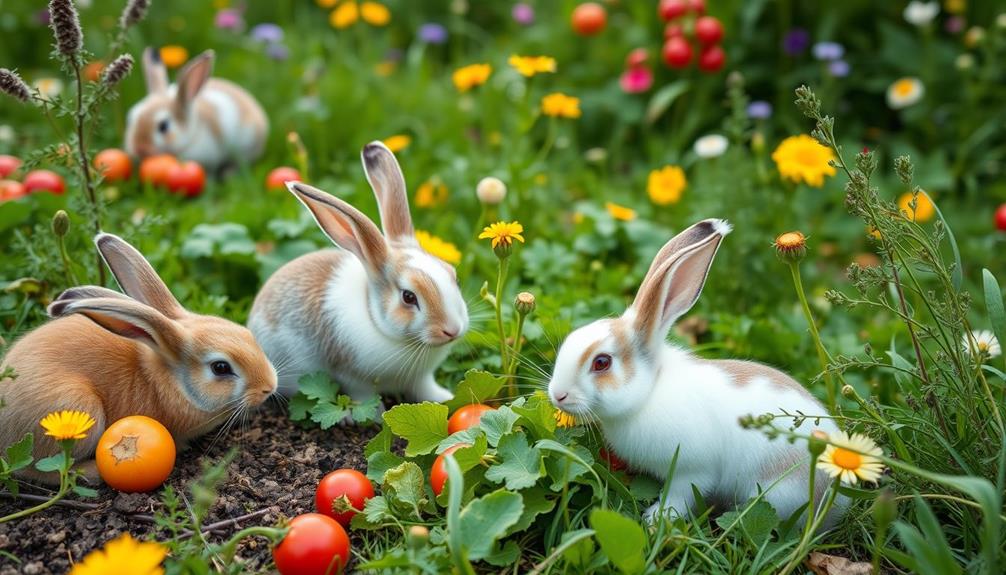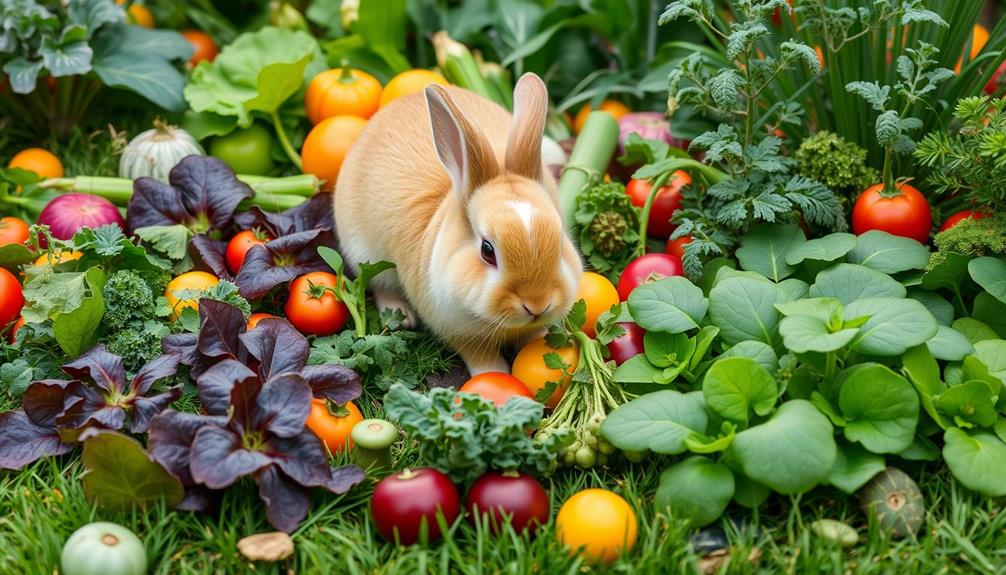To guarantee your rabbit's ideal health, focus on a diet rich in high-quality grass hay, which should make up 85-90% of their daily intake. Offer 1-2 cups of fresh vegetables daily, with a variety of leafy greens as the main choice. Limit pellets to about 1/4 cup if your rabbit weighs between 6-10 lbs. Make certain clean, fresh water is always available. Treats can be given sparingly, primarily as small amounts of vegetables or fruits a couple of times a week. If you want to discover other tips for maintaining your rabbit's diet and health, you'll find more ahead.
Key Takeaways
- Rabbits should primarily consume high-quality grass hay, making up 85-90% of their daily diet for optimal health.
- Fresh vegetables should be offered daily, with 1-2 cups per 4 lbs of body weight, focusing on leafy greens.
- Limit pellets to 1/4 cup daily for adult rabbits, ensuring they are high-fiber and free from harmful ingredients like corn and nuts.
- Always provide clean, fresh water in a heavy bowl, checking levels twice daily to ensure hydration.
- Treats should be given sparingly, consisting mainly of fresh vegetables or fruits, limited to 1-2 tablespoons per 5 lbs of body weight.
Rabbit Diet Essentials
When it comes to your rabbit's diet, it's important to prioritize high-quality grass hay, which should make up about 85-90% of their daily intake. Hay is significant for maintaining your rabbit's digestive systems and preventing dental issues.
Additionally, consider the importance of providing a variety of fresh vegetables to keep your rabbit interested in their meals, as popular vegetable options can enhance their diet. Alongside hay, incorporating fresh, leafy greens into their meals is essential. Aim for 1-2 cups of veggies per 4 lbs. of body weight each day, gradually introducing new options to avoid any digestive upset.
While pellets can be included, keep them to a minimum—about 1/4 cup for adult rabbits weighing 6-10 lbs. Choose pellets that are high in fiber and free from seeds or high-sugar ingredients.
Always make sure your rabbit has access to clean drinking water, available 24/7. A heavy ceramic bowl works best to prevent tipping, so check it regularly for cleanliness.
Treats should be given sparingly, primarily small amounts of fresh vegetables or fruits. Remember, fruits should only be offered 1-2 times a week due to their high sugar content.
Vegetable Choices and Guidelines

Fresh vegetables play an essential role in your rabbit's diet, providing important nutrients and variety. Leafy green vegetables should make up a significant portion of their intake. Aim for at least 1-2 cups per 4 lbs of body weight, introducing a variety of at least three different types daily.
It's imperative to wash the vegetables thoroughly before feeding your rabbit to guarantee cleanliness and safety. While high-calcium greens like collard and kale are beneficial, offer them in small amounts to prevent bladder stones. Avoid starchy vegetables and high-sugar fruits, as they can lead to health issues. Additionally, steer clear of iceberg lettuce and celery; these foods have low nutritional value.
When giving new vegetables, introduce them slowly and monitor for any digestive upset. If your rabbit experiences soft stools, eliminate that vegetable from their diet.
Here's a quick overview of vegetable choices:
| Vegetable Type | Guidelines |
|---|---|
| Leafy Greens | Feed daily, at least 3 types |
| High-Calcium Greens | Offer in small amounts |
| Starchy Vegetables | Avoid or give sparingly |
| Low Nutritional Value | Completely avoid |
Feeding Frequency and Hydration

Rabbits need consistent access to fresh, clean water to stay healthy and hydrated. You should provide a heavy ceramic bowl for easy access and to prevent spills, as it's important to check this water source at least twice daily. This is especially vital during winter, when water can freeze.
Additionally, maintaining good air quality in your rabbit's environment is essential, as air purifiers improve indoor air quality considerably and can help reduce allergens that may affect your pet.
In addition to hydration, rabbits need to eat a balanced diet to thrive. Hay should be available at all times, making up 80-90% of their diet, which promotes proper digestion and overall health. For adult rabbits, daily feeding of fresh vegetables is essential; aim for 1-2 cups of vegetables per 4 lbs of body weight. Introduce new vegetables gradually to avoid digestive issues.
While treats can be tempting, remember to limit them to 1-2 tablespoons per 5 lbs of body weight, given once or twice a week. This helps prevent obesity and maintains a balanced diet.
Treats and Special Considerations

Your rabbit's health can be greatly influenced by the treats you choose to give. It's important to focus on healthy options that contribute positively to their well-being. Limit treats to small pieces of fresh, washed vegetables and avoid high-calorie treats like cookies, nuts, and grains.
Fruits can be an occasional delight, but keep it to 1-2 tablespoons once or twice a week due to their sugar content, which can upset your rabbit's gastrointestinal health. While high-calcium greens like collard and kale are nutritious, they should be given sparingly to prevent bladder stones.
Incorporating chew toys such as wooden blocks and hay balls is vital for dental health, as they help wear down your rabbit's continuously growing teeth. Consult with your veterinarian about suitable treats to make certain you're steering clear of high-calorie options that could lead to obesity.
Here's a quick reference table for your rabbit's treat options:
| Healthy Options | Limitations |
|---|---|
| Fresh Vegetables | High-Calorie Treats |
| Fruits (1-2 tbsp/wk) | High-Calcium Greens |
| Chew Toys | |
Unique Rabbit Behaviors

Understanding unique rabbit behaviors is essential for any rabbit owner, as these quirks reveal a lot about their needs and well-being. One fascinating behavior is coprophagy, where rabbits consume cecotropes—special fecal pellets produced at night. This process allows them to reabsorb important nutrients like protein and vitamins B and K, critical for their healthy digestive system.
Additionally, providing a balanced diet and regular exercise can contribute to their overall health and well-being, similar to how a holistic lifestyle approach can alleviate menopause symptoms.
Rabbits are also natural foragers. They thrive when you provide constant access to good quality hay, fresh greens, and grasses. This high-fiber diet is necessary not only for their digestion but also for their dental health. Continuous tooth growth means they require plenty of chewing opportunities to prevent dental diseases.
Moreover, social interaction plays a significant role in a rabbit's life. These social animals need companionship, so consider bonding with them or introducing another rabbit. A stimulating environment where they can explore and interact enhances their mental well-being.
Health Monitoring and Maintenance
To keep your rabbit healthy, regular weight checks and routine vet visits are essential.
It's also important to observe any changes in your rabbit's behavior or mood, as these can sometimes indicate underlying health issues, similar to how mental health support is vital for those at risk of dementia.
You'll want to monitor their eating habits closely, as changes can signal health issues.
Keeping a log of dietary changes will help you spot trends and communicate effectively with your veterinarian.
Weight Management Strategies
Maintaining a rabbit's weight is vital for its overall health and well-being. Regular weight checks help you identify dietary issues and guarantee your rabbit stays within a healthy weight range, ideally between 2-6 pounds for most breeds.
To achieve effective weight management, adjust the amount you feed based on your rabbit's age, lifestyle, and health status. Growing, pregnant, or nursing rabbits need more food than adults, so be mindful of their needs. Incorporating a variety of fresh vegetables and high-quality hay into their diet can support healthy lifestyle blogs that promote ideal nutrition for rabbits.
It's important to monitor eating and drinking habits closely. Any sudden changes might indicate underlying health problems that require veterinary attention. Overweight rabbits face risks related to obesity, so manage their intake of pellets and treats to prevent excessive caloric consumption.
Using good quality hay and fresh vegetables as the primary components of their diet for pet rabbits will help keep them healthy. Keeping a log of dietary changes and health observations can aid in recognizing patterns, making it easier to address any potential issues early on.
Routine Health Check-ups
Routine health check-ups are a key part of ensuring your rabbit stays healthy and happy. Regular veterinary check-ups play an essential role in preventative care, helping you spot potential health problems before they escalate.
During these visits, your vet will monitor your rabbit's healthy weight, which can vary by breed and age. It's also important to keep in mind that dietary modifications can considerably impact your rabbit's overall health, similar to how hydration strategies can optimize metabolism in other animals.
It's essential to stay vigilant for any changes in eating habits or drinking patterns, as these can signal underlying health issues. Keeping a log of these changes can be invaluable during vet visits, allowing for more effective diagnosis and treatment.
Additionally, monitoring droppings is crucial; they can reveal a lot about your rabbit's digestive health. Awareness of common health issues like gastrointestinal stasis and dental disease can further aid in maintaining your rabbit's well-being.
Common Dietary Myths and Facts

You might think carrots are a staple in your rabbit's diet, but they're actually high in sugar and should only be given as treats.
Many also believe lettuce is safe, but iceberg lettuce lacks nutrition and can be harmful in large amounts.
It's important to understand that rabbits, like cats, have specific dietary needs and can experience health issues from inappropriate foods.
It's a common misconception that pellets are necessary—your rabbit needs unlimited hay and only a small portion of pellets for a balanced diet, as indicated in cat health and nutrition.
Carrots Are Essential
While many people believe that carrots are a rabbit's best friend, this common myth can lead to dietary missteps. In reality, carrots have a high sugar content that can cause obesity and serious digestive issues if fed in excess. You should only offer them as an occasional treat in small quantities—about 1-2 tablespoons per 5 lbs of body weight.
To guarantee your rabbit's health, consider incorporating products that offer essential nutrients, similar to how garage door openers enhance security by integrating modern technology into your home.
Instead of relying on carrots, focus on providing your rabbit with a balanced diet rich in high-quality hay and fresh leafy greens.
Here's what to keep in mind:
- Limit carrots: Offer them only occasionally and in small quantities.
- Prioritize greens: Fresh leafy greens should make up a significant portion of their daily diet.
- Monitor health: Always introduce new foods gradually and watch for any adverse reactions, especially in ill rabbits.
Lettuce Is Safe
Many rabbit owners often believe that all types of lettuce are safe for their pets, but this isn't entirely true. While some leafy greens can be beneficial, iceberg lettuce, in particular, lacks nutritional value and can cause digestive upset in rabbits. Instead of relying on lettuce as a staple, consider offering romaine lettuce, which is a better choice due to its higher nutrient content.
Additionally, providing a varied diet can help achieve ideal health benefits for your rabbit. It's important to provide greens only in moderation. Excessive amounts of lettuce can lead to gastrointestinal issues, and it shouldn't replace the primary diet of high-fiber hay.
A varied diet is essential for your rabbit's ideal health, so focus on incorporating a mix of safe vegetables along with hay. When introducing new greens or vegetables, do so slowly and observe your rabbit for any adverse reactions.
Many rabbit owners mistakenly think all greens are safe, but it's crucial to be cautious. By prioritizing high-fiber hay and selecting appropriate vegetables, you can guarantee your rabbit maintains a balanced diet that supports its overall well-being. Remember, moderation is key when it comes to incorporating lettuce into your rabbit's diet.
Pellets Are Necessary
Rabbits thrive on a well-rounded diet, and pellets play a role in that mix, but they shouldn't be the main focus. Instead, the cornerstone of your rabbit's diet should be fresh hay and greens.
Adult rabbits typically need around 1/4 cup of high-fiber pellets each day, while those under 5 lbs should get about 1/8 cup. Overfeeding pellets can lead to obesity and gastrointestinal issues, so it's vital to strike a balance.
A well-balanced diet can include various vegan alternatives for other pets that may be considered alongside rabbit care.
To guarantee your rabbit enjoys peak health, consider the following:
- Choose pellets made primarily from hay, preferably timothy hay.
- Avoid pellets with corn, nuts, or seeds due to their high sugar content.
- Read ingredient labels to confirm pellets are dark green and free from artificial additives.
Frequently Asked Questions
What Is the Healthiest Food for Rabbits?
To guarantee your rabbit's health, focus on high-quality grass hay, fresh leafy greens, and limited pellets. Always provide fresh water. This balanced approach supports digestion, dental health, and overall well-being for your furry friend.
What Are the Major Nutrients Required in a Rabbit Diet?
As you watch your rabbit hop around, consider the major nutrients it needs—fiber for digestion, protein for growth, vitamins for health, and minerals for strong bones. Balancing these keeps your furry friend thriving and energetic.
How Can I Make My Rabbit Healthy?
To keep your rabbit healthy, provide a balanced diet, guarantee they get plenty of hay, fresh greens, and clean water. Monitor their weight, offer limited treats, and schedule regular vet check-ups for overall well-being.
What Makes a Good Rabbit Food?
Did you know that 80-90% of a rabbit's diet should be high-quality grass hay? To guarantee your rabbit stays healthy, focus on providing hay, fresh greens, limited pellets, and occasional fruits for balanced nutrition.
Conclusion
In the grand symphony of rabbit care, feeding your fluffy friend the right diet isn't just important—it's the crescendo that leads to a long, joyful life! Picture your rabbit, bounding like a tiny kangaroo, fueled by vibrant veggies and crunchy hay. By giving them the right balance, you're crafting a feast fit for a royal rabbit banquet! So, grab those greens, fill their bowl, and watch as they thrive like the majestic creatures they are!










